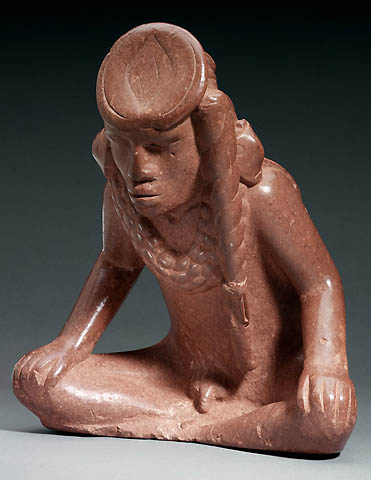
FAYETTEVILLE, Ark. – The University of Arkansas Museum will loan the “Resting Warrior” effigy pipe to the Musée du quai Branly in Paris from April to July 2014. The University Museum will also join with the Arkansas Archeological Survey to loan 54 vessels to the Downstream Casino Resort in Quapaw, Okla.
The effigy pipe, popularly known as “Big Boy” will be included in the Musée du quai Branly (Museum of Tribal Art) exhibit on the Plains Indians titled “Les Indiens des Plaines, Art et Vie” (The Plains Indians, Art and Life).
"Education is a big part of our mission, and one way we accomplish this is by loaning artifacts to other museums,” said Mary Suter, curator of collections for the University of Arkansas Museum. “With the loan of the effigy pipe to the Musée du quai Branly, the museum shares an important cultural artifact with an international audience, and later, when the exhibit travels, with a wider national audience.”
After its time at Musée du quai Branly, the exhibit will move to the Nelson-Atkins Museum of Art in Kansas City from September to December 2014 and then to the Metropolitan Museum of Art in the spring of 2015.
“Big Boy” is well known in archeological circles and was most likely made at Cahokia, a large ceremonial mound complex in southern Illinois. At some point, the effigy pipe was taken to Spiro Mounds, just west of Fort Smith. When the mound was excavated in the ‘30s, the objects found in the mound were sold to collectors. Sam Dellinger, the first director of the University Museum, acquired the effigy pipe from a collector in the ‘40s. .
The exhibit on the Plains Indians is organized by the Musée du quai Branly and curated by Gaylord Torrence, senior curator of American Indian Art at Nelson-Atkins. The majority of objects date from the 18th and 19th centuries. Contemporary works will form a significant component of the exhibition as well.
Of the 54 items to be featured at Downstream Casino Resort, the University Museum is providing 23 vessels from the Mississippian Period. The remaining 31 are from the Arkansas Archeological Survey. The resort is owned and operated by the Downstream Development Authority for the Quapaw Tribe. John Berrey, chair of the authority, is a University of Arkansas graduate. The display may be viewed in the new exhibit cabinets in the casino’s lobby area.
“With the loan of Mississippian Period whole vessels to Downstream Casino Resort we can share objects related to Quapaw cultural heritage, objects that the museum was able to preserve from a time when Native Arkansans had little voice in the preservation of their culture,” said Suter. “Hopefully these loans will inspire people to appreciate and learn more about Native American culture and heritage, and incidentally raise awareness of the diverse objects we have in the Museum collections.”
The vessels are from the Arkansas River Valley and Northeast Arkansas, areas that are traditionally culturally affiliated with the Quapaw.
Contacts
Darinda Sharp, director of communications
J. William Fulbright College of Arts and Sciences
479-575-4393, dsharp@uark.edu
Augusta Fields, communications intern
J. William Fulbright College of Arts and Sciences
479-575-3712, akfields@uark.edu